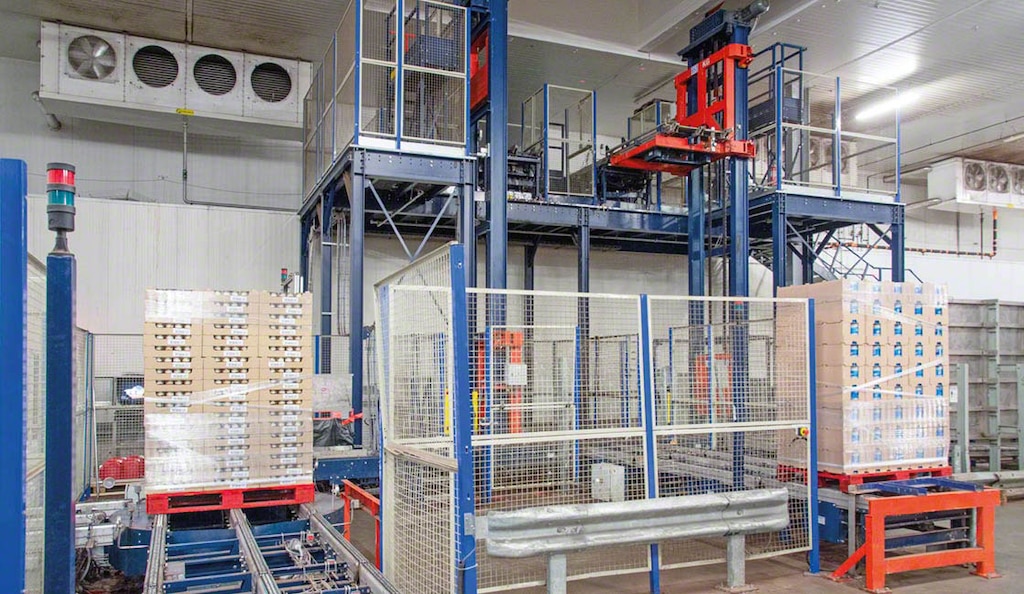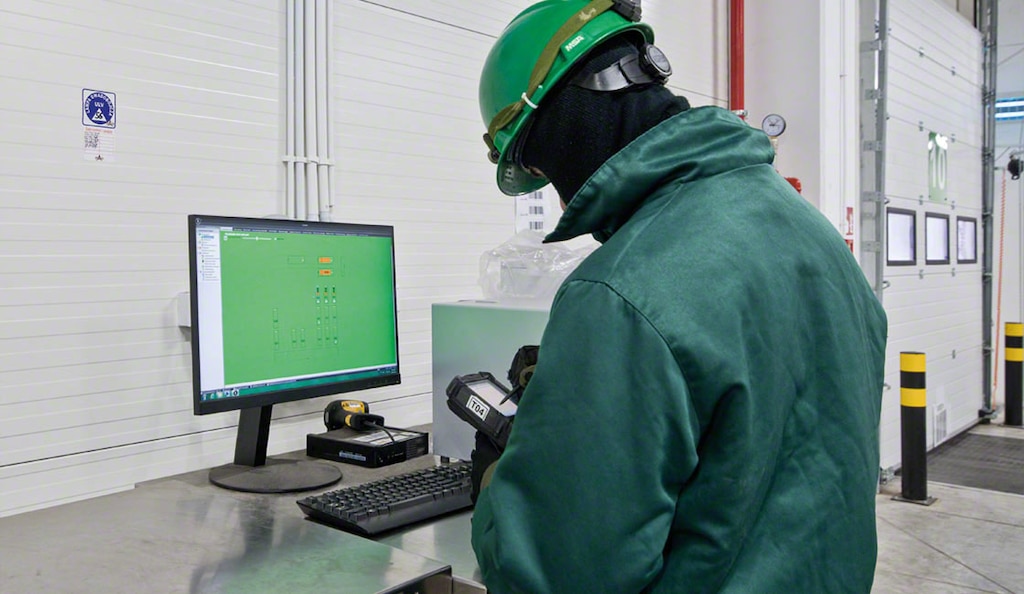
The cold chain in logistics
The cold chain is crucial for preserving the quality of food and medicine. Even though the method has been around for a long time, companies can now leverage the latest technologies to safeguard the integrity of these goods throughout every stage of logistics. In this post, we take a closer look at how the cold chain works, which industries rely on it, and the best ways to keep it intact.
What is a cold chain and what does it do?
The cold chain is a set of processes and procedures that maintain a controlled temperature throughout the supply chain. It enables heat-sensitive goods to retain their properties, preventing spoilage and bacterial growth. This makes it a critical system for storing and transporting perishable items such as food, medicine, cosmetics, and laboratory products.
To keep the cold chain unbroken, different temperature ranges are used depending on the product. Ultra-low freezing is ideal for certain vaccines and biological samples. Deep freezing is used for items like meat, seafood, ice cream, and frozen vegetables. Superchilling works well for premium fish and shellfish. Standard refrigeration is common for dairy, fresh meat, cold cuts, and delicate fruits and vegetables. Finally, controlled refrigeration ensures the stability of vaccines, insulin, pharmaceuticals, and other biological products.
How the cold chain works
In logistics, the cold chain involves three main components:
- Cold storage. This requires specialized facilities, such as temperature-controlled chambers built with sandwich panels. These spaces are equipped with refrigeration systems made up of compressors, condensers, expansion valves, and evaporators. Storage racks designed for these environments — like those from Interlake Mecalux — are made of stainless steel to withstand extreme cold.
- Transportation. Temperature-sensitive products must be moved using refrigerated vehicles that can monitor and log internal temperatures. This helps guarantee that goods arrive at their destination in optimal condition.
- Temperature control. Monitoring must take place throughout the supply chain — from origin to final delivery — whether at distribution centers (DCs) or points of sale.
Cold temperatures slow the growth of harmful microorganisms such as bacteria. However, cold alone can’t destroy pathogens that are already present. That’s why the cold chain must be kept intact, all the way to the point of consumption.
A broken cold chain can lead to lost product quality, reduced effectiveness of medications or vaccines, and serious health risks for consumers. For example, once food has been thawed, it should only be refrozen if it’s been cooked to at least 158 °F. Otherwise, the break in the cold chain could compromise its safety.
Cold chain regulations
There’s no single global authority that governs cold chain practices, but a wide range of standards and regulations apply depending on the industry and country. Therefore, companies must understand and comply with the specific requirements relevant to their operations.
One of the most widely recognized systems for ensuring food safety is Hazard Analysis and Critical Control Points (HACCP). Designed to prevent issues like cold chain failure from compromising product integrity, the HACCP process identifies potential hazards, determines high-priority control points, sets acceptable limits, establishes monitoring procedures, and outlines corrective actions when needed.

Industries that rely on the cold chain
Cool chain systems are used across a wide range of industrial sectors due to the temperature-sensitive nature of many of their products. These are some of the most prominent:
- Food. Dairy products supplier and distributor Producers Dairy installed a semi-automated Pallet Shuttle for its 50,000 ft² cooler at its plant in Fresno, California. The shuttles follow orders sent by an operator through a Wi-Fi-connected tablet specially designed for low-temperature environments like the 40 °F cooler at Producers Dairy.
- Beverages. Manufacturers and distributors of beverages must guarantee product quality, traceability, and safety at all times. French dairy company Laiterie Saint-Père, part of the Intermarché Group, runs an automated pallet warehouse in Saint-Père-en-Retz. Mecalux equipped the facility with sandwich panels and cooling systems to maintain a steady temperature of 36 °F.
- Cosmetics. Certain personal care products require cold storage to preserve their effectiveness. Cosmopak is a cosmetics manufacturer with a production center in Ovar, Portugal. It uses a 486-foot-long automated warehouse designed by Mecalux to store its raw materials under ambient or refrigerated conditions. The facility accommodates up to 3,800 pallets.
- Pharmaceuticals. Cold storage is paramount for preserving the properties of many medications and treatments. Mega Pharma, a leading pharmaceutical company in Uruguay, constructed an automated rack-supported building with a capacity of over 6,900 pallets. The warehouse measures 236' long, 39' wide, and 79' high and is kept at a controlled temperature.
Cold chain solutions
Maintaining the cold chain ensures the quality, shelf life, and safety of temperature-sensitive products. To achieve this, a range of tools and systems are available:
- Cold stores. Cold-storage warehouses often use high-density systems to protect heat-sensitive goods. By maximizing storage capacity, these solutions minimize the volume that requires cooling, improving energy efficiency. Automated storage and retrieval systems (AS/RSs) offer additional benefits, such as limiting workers’ exposure to cold and preventing temperature fluctuations during handling.
- Warehouse management system (WMS). Knowing exactly where products are at all times (in intralogistics operations and other supply chain links) enables quick identification and provides information relevant to their storage requirements. Easy WMS manages all warehouse operations and resources, coordinating both physical flows and digital records. It allows for full, real-time inventory traceability across the supply chain.
- Temperature and humidity monitoring. Sensors track environmental conditions throughout storage and transportation. Internet of Things (IoT) technology makes it easier to detect deviations that could lead to microbial growth, nutrient loss, or reduced drug stability.
- Ruggedized devices. Built to withstand harsh conditions like freezer warehouses, shock-resistant mobile devices are indispensable tools for the cold chain logistics industry.
- Refrigerated vehicles. These trucks feature insulated cargo compartments and built-in cooling units to keep products chilled or frozen throughout transit.

Technology: A key ally in cold chain management
The cold chain is vital for preserving the integrity of food, medicine, and other biological goods. Technological solutions optimize operations throughout the chain, from product storage to transportation and monitoring. They help ensure the quality, safety, and shelf life of goods while supporting compliance with regulations.
Similarly, AI-powered WMS solutions optimize storage and inventory turnover, reducing waste. In DCs, robotics and automation speed up loading and unloading processes, limiting exposure to inadequate temperatures and preserving cold chain integrity. Ultimately, the synergy between technology and the cold chain is fundamental for maintaining product quality, safety, and sustainability.
The cold chain in 5 questions
What is the cold chain?
The cold chain is a temperature-controlled supply chain used to store, transport, and distribute perishable products that require refrigeration or freezing.
How does the cold chain work?
Cold temperatures slow down the growth of microorganisms but don’t eliminate them. That’s why cold-chain logistics management aims to keep products within a specific temperature range throughout all stages: refrigerated storage in specialized warehouses, transportation in temperature-controlled vehicles, and continuous monitoring up to the point of sale.
Where is the cold chain used?
The cold chain is essential in industries such as food, cosmetics, and pharmaceuticals, where product quality, safety, and effectiveness depend on consistent temperature control.
What systems help protect the cold chain?
This chain is supported by efficient cold-storage warehouses, accurate traceability, real-time temperature and humidity monitoring with IoT sensors, rugged devices for cold environments, and temperature-controlled transportation vehicles.
What regulations apply to the cold chain?
There’s no single global regulation for the cold chain. Instead, various industry-specific and national standards apply. One widely adopted framework is the Hazard Analysis and Critical Control Points (HACCP) system, which helps ensure food safety by identifying and controlling high-risk factors such as temperature.
